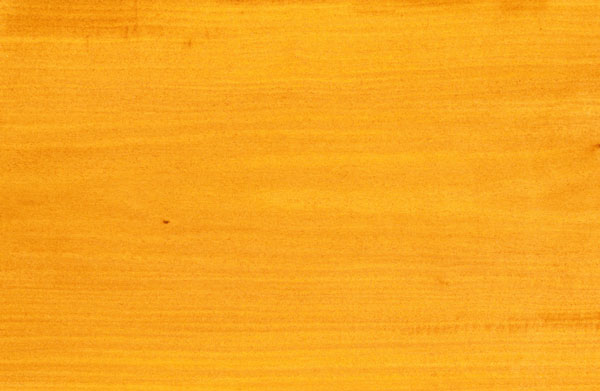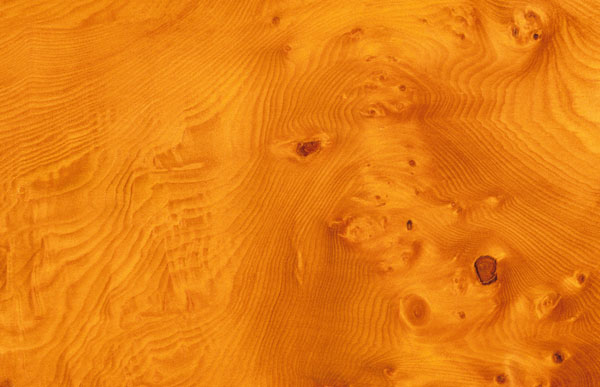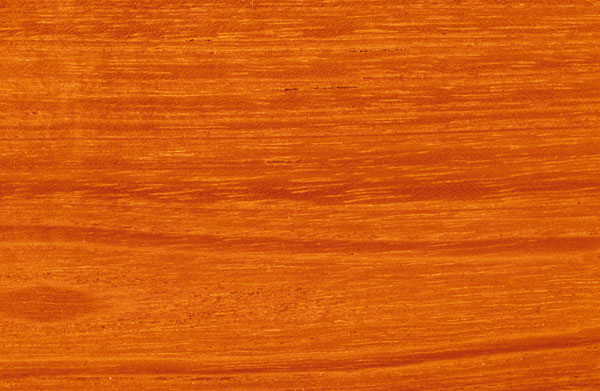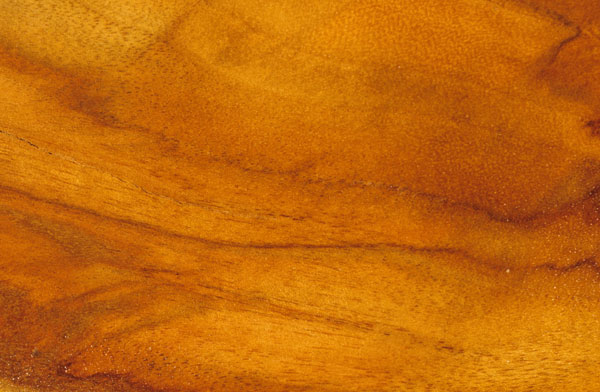Scented Woods
Above: King Billy pine, red cedar, sandalwood
Words: Jugo Ilic
There is nothing like walking into a workshop and being confronted with the odour of some exotic wood being machined. My earliest experience with this was during my early days of work at CSIRO Division of Forest Products. The workshop wizards, albeit some with less than ten fingers, were sawing up samples of wood for distribution to forestry schools. I later learned the wood was rose mahogany (Dysoxylum fraseranum) and not at all exotic. Of the thousands of woody species from both hardwoods and softwoods, there is a small number which exhibit a distinctive odour when sawn. This can be different from trees which have scented foliage or bark.
Where does the odour come from?
Distinctive odour comes from the chemical nature of the heartwood extractives (infiltration products) and their emission as free molecules into the surrounding air. The main chemical substances, namely, cellulose and lignin, are common to all woody species, but there may also be present (in large or small quantities depending on the species) such substances as tannins, sugars, starches, acids, oils and mineral salts.
Generally as the tree grows new sapwood is formed by the living cells of the cambium (that slimy part of the tree or branch just under the bark). When sufficient sapwood is formed that is required for the life and growth of the tree the innermost cells die and transform into heartwood. These cells slowly fill with tannins, resins and other substances from the living material in the cells making the wood usually darker in colour and more resistant to decay and insect attack.
In addition to the proportion, the chemical nature of these substances may vary from species to species. Thus there are numerous types of tannins, some of which colour iron salts green, while others give a blue colouration; numerous kinds of sugars for each of which characteristic chemical tests are known; characteristic and readily detected essential oils, as in Huon pine, the cypress pines and sandalwood.
The chemical nature of the mineral constituents is reflected in many cases in the way in which a timber burns as well. Consequently it is the oils, resins from the wood extractives that give rise to the distinct odour. However, because odours arise from volatile molecules emitted to the air, the odour can dissipate quickly unless the wood is freshly cut by making new cuts or scrapings from the heartwood.
Moistening and warming the surface by breathing on it can help increase the odour but it must be remembered that odour varies considerably with the age and previous history of the timber. Green timber can often have a characteristic odour which tends to disappear on drying or exposure to the air.
Distinctively scented
The characteristic distinctive odour of woods can be as pleasant as that of sandalwood or Huon pine (Lagarostrobos franklinii) and is not likely to be forgotten. Among the cedars, odours of pencil cedar, red cedar (Toona) and cigar-box cedar (Cedrela), the guareas (Guarea cedrata) have an equally characteristic cedar-like smell.

King William Pine (Athrotaxis selaginoides)
King William Pine (Athrotaxis selaginoides), a Tasmanian softwood, has a characteristic cedar-like odour similar to Japanese sugi (Cryptomeria japonica). Wood of Port Orford cedar (Chamaecyparis lawsoniana), has a pungent spicy smell. Raspberry jam (Acacia acuminata) lives up to its name.

Raspberry jam (Acacia acuminata)
Woods categorised as cedars generally have an agreeable scent. Oily looking samples of bald cypress on the other hand can smell rancid, and catalpa smells like kerosene. Wood from true firs (Abies), spruce (Picea) and hoop pine (Araucaria) tend to be ‘neutral’, and are a good choice for food containers as they will not affect even easily tainted butter. On the other hand, the scent of camphor laurel (Cinnamomum) often used in chests and cabinets can inhibit insect activity.
It is believed that the scent of Spanish cedar (Cedrela) enhances the aroma of tobacco, and burning sandalwood and gaharu (sometimes called eagle wood—Aquilaria malaccensis) as incense, has been used for centuries. The tree under normal circumstances produces a pale coloured and odourless wood but when the tree is invaded by a fungus (Phialophora parasitica), the relatively light and pale coloured heartwood changes to a dark colour from the embedded aromatic resin in response to the attack. The resinified wood is commonly called gaharu, aloeswood, or agarwood, and is highly valued in many cultures for its distinctive fragrance, and thus is used for incense and perfumes.
Sandalwoods

Sandalwood (Santalum spicatum)
The best known and most important genus is Santalum of the East Indies, Polynesia and Australia. The use of the fragrant wood oil of the Indian sandalwood species Santalum album is of great antiquity. In the 1840s reports reached Western Australia of the high prices being paid in Singapore for sandalwood. At that time WA had a large imbalance of trade but in clearing land it was removing sandalwood trees (Santalum spicatum) — burning them or using them for building posts. However, export began soon after and grew to account for more than half the colony’s export income. When export restrictions were placed for sandalwood from India, WA sandalwood exports rose and reached a peak in the 1920s. The amount cut has declined over recent years, with the remaining material being found only in remote desert areas (Hillis 1987) . These days the wood is used for the extraction of sandalwood oil for perfumery, incense and medicinal uses.
Sandalwood is a parasitic small tree that establishes on the roots of host trees such as raspberry jam. It is commonly 2–3 metres tall, growing occasionally to 8m, and the bark is rough, dark brown to black. It grows in the Pilbara, Gascoyne, Murchison and Goldfields, and is widely distributed from Shark Bay through the Wheatbelt and Goldfields to the South Coast. It also grows in South Australia. The tree takes about 20–30 years to produce exploitable heartwood.
The heartwood is yellow-brown with a distinctive fragrance. Green density is about 960 kgm3, air-dry density about 900 kgm3, and basic density about 785 kg/m3. The timber turns and carves beautifully and takes a good finish. It is highly resistant to termite attack and the tangential and radial shrinkages are about 1.6 and 1.4 per cent respectively, the values being at least five times lower than for eucalypts.
A number of other woods have a similar scent to sandalwood. False sandalwood also known as budda (Eremophilla mitchelli) is usually a multi-stemmed shrub or small tree which occurs in NSW and Queensland. The wood has a narrow sapwood zone; the heartwood is pale buff to brown often darkening. It has a lovely lustre and figure. The timber is dense (>1000 kgm3), strong, hard and tough. It carves cleanly producing a nice wavy appearance and turns cleanly.
Another false sandalwood, ‘bastard sandalwood’ or naio (Hawaii) (Myoporum sandwicense) was used instead of true san- dalwood because its scent was similar when the wood was burned.
Sugar wood (Myoporum platycarpum) is known also as sandal or bastard sandalwood, or sugar-tree. The wood has a light walnut colour, is fragrant when cut and often shows birdseye mottling, espe- cially in burrs. It is fine-grained and takes a fine polish.
Dedaru or daru-daru (Cantley corniculata), occurs in Malaysia to Indonesia, to Borneo (Sabah and Sarawak). It is a heavy hardwood 840–1360 kgm3. Heartwood is yellow brown, the texture is fine and it has a ribbon figure on the radial surface. A freshly cut surface exhibits a fragrance similar to sandalwood but with a hint of orange. This is a fairly rare timber but occasionally comes in with shipments of heavy shorea (balau). The fragrant wood is reputed to have been exported to China. Otherwise locally it is used for bridge and ship building, heavy duty flooring, piling and fancy turnings.
NSW rosewood

NSW rosewood (Dysoxylum fraseranum)
Also known as rose mahogany, the heartwood of Dysoxylum fraseranum is very deep pink or red-brown, sometimes weathering to a rather orange colour, with a distinctive rose-like fragrance, usually persistent. The timber has a fine and fairly uniform texture, characterised by a fine tracery of soft tissue on backsawn faces and by a glistening of minute gum deposits in the vessels. The sapwood is often wide and conspicuously lighter in colour than the heartwood and is susceptible to lyctus borer (powder post beetle) attack.
NSW rosewood is essentially a cabinet timber, somewhat on the heavy side. Owing to its ease of working and finishing it has been used for turnery and carving as well as interior joinery and flooring and it was once popular for use as printer’s blocks. The timber can show a tendency to sweat causing a dull and blotchy finished surface from the presence of drops of free aromatic oil which comes to the surface. Sponging the timber with metho will remove it. Its availability is limited to mainly re-cycled wood otherwise it is no longer available as a commercial species.
Miva mahogany (Dysoxylum muelleri) is similar in appearance to rose mahogany and when freshly cut smells like turnips (sometimes it’s called turnip wood). It has been known since the early 1900s to cause severe irritation of the mucous membranes. Dry dust was known to cause violent coughing and a feeling of heaviness in the lungs.
Huon pine

Huon pine (Lagarostrobos franklinii)
The species is confined to western Tasmania and restricted to river banks. Over a period of hundreds of years it can grow to 28–30m. Light yellow to yellowish brown in colour, and the timber is beautifully marked with dark wavy lines (growth rings) and small knots, light, close-grained. The wood is smooth and oily to the touch and easily worked, turned and finished. With an air-dry den- sity of 520 kgm3 it is among the lowest shrinkage timbers. Its uses are for boat-building, carving, and formerly for bedroom furniture, and burns briskly with a characteristic aromatic fragrance and when distilled produces an essential oil. Except for fallen trees, it is no longer commercially available.
Cedars
The name was originally applied to the Lebanon cedar (Cedrus libani) then to other species of the genus, to various junipers and other coniferous woods, and to many other woods of broad-leaved trees, especially the botanical family Meliaceae genus Cedrela, most of which resemble the true cedar in being brown, even-grained woods of moderate hardness and with a fragrance. The wood has a pleasant odour, which is obnoxious to insects.

Australian red cedar (Toona ciliata)
The ‘cedar’ of the English timber trade is the West Indian, cigar box cedar (Cedrela odorata), a close relative of Australian red cedar (Toona ciliata). Like its relative, it has cream coloured sapwood which is clearly demarcated from the pale brown heartwood, when first cut then darkens to a rich reddish brown. Wood vessels (pores) are often filled with gummy deposits. The grain is straight and texture medium to coarse. Growth rings are distinct due to ring porosity. Quartersawn faces often exhibit fiddleback or ribbon like figure. The wood has a characteristic and fairly long lasting rosy scent. The timber is light and soft and is easy to saw and planes to a smooth surface.
Camphors

Camphor (Cinnamomum camphora)
Camphor (Cinnamomum camphora) is a native of Taiwan and can reach heights of 10–20m. The wood is light-coloured, fragrant and soft. It is used for entomological and ornamental cabinets and is the source of most of the camphor of commerce which is obtained by destructive distillation.
Kapur (Dryobalanops aromatica) is a large tree that grows in Malaysia and Indonesia; to heights between 50 and 100m and 1–1.5m in diameter. Heartwood is light red to reddish brown, resembling Honduras mahogany, fragrant with a camphor-like scent that persists even in dry stock. Crystal camphor (pure form) can be extracted from the wood. The wood is straight-grained, moderately hard, tough and durable. It is used for planks, beams and piles. Some species of keruing (Diperocarpus spp.) have a similar camphor-like scent but the wood is usually not durable and is considerably paler in colour.
Coachwood

Coachwood (Ceratopetalum apetalum)
Coachwood (Ceratopetalum apetalum) is also known as light-wood or leather-jacket and grows to 15–25m. The timber is soft, light, close-grained, and exceedingly tough, with basic density 500 kg/m3 and with the fragrance of caramels or sometimes of freshly mown hay. The heartwood has straight grain fine texture and is often highly figured resulting from a fine tracery of soft tissue. Coachwood used to be favoured for coach-building, tool handles, cabinetry and boat-building and can useful as an alternative for musical sound-boards. The species was the basis of the development of Australia’s plywood industry in the early days but is now in short supply. Coachwood is sometimes applied to Schizomeria ovata, an allied reddish wood of inferior character, known also as white cherry but it is without a distinct odour.
Scent is one of wood’s most characteristic and appreciated features, and can be exploited for both aesthetic and commercial reasons.
Dr Jugo Ilic is a wood scientist and author of numerous publications on wood anatomy and identification, as well as
a database of botanical and common names of world woods. He is a regular contributor to Australian Wood Review. In issue 104 he writes about how, why and when wood can bend.



